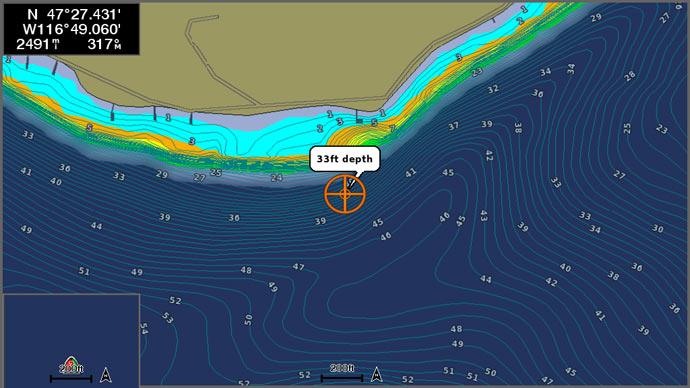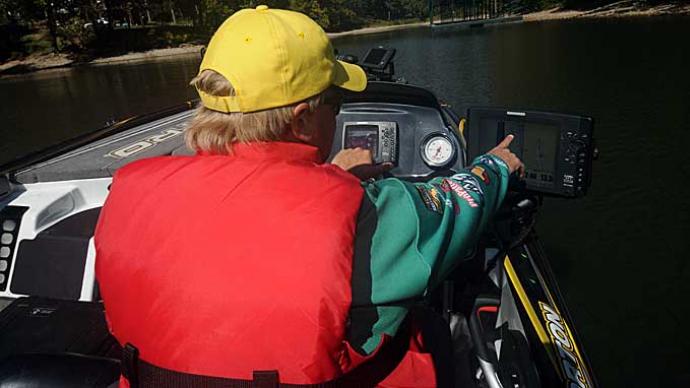
Over the past few years, nothing has energized (and polarized) bass fishermen more than forward-facing sonar. The popularity of the new technology has opened up a new world for fishing, and now, anglers can scan in front of the boat and pan their trolling motor to view the underwater world, including structure, cover, and bass. The best part is that the view is real-time or "live" and not just static images like standard sonar.
With many anglers adding this technology to their boats, learning to fish effectively with forward-facing sonar is a hot topic. Here are a few tips to speed up your learning curve.
It's Not Magic
While very helpful at times, the first thing to remember is that this is a tool and not magic. You will not immediately catch every fish in the lake. Locating fish and using this technology to the maximum potential still requires instinct and knowledge of where fish should be located based on seasonal patterns. Adding this to your repertoire will expand the situations where you can catch fish and increase the number of bass you catch yearly.
Another thing to remember is that just because you see bass on your electronics doesn't mean they will bite. Forward-facing sonar is very helpful and sometimes makes fishing much easier, but there are instances when it can lead to frustration with fish that do not want to eat your lure and run away from your baits. Another pitfall is that it's difficult to determine which fish are bass or other species. There are some clues about how fish are swimming and their size, but you may end up fishing for something besides bass, which can quickly lead to wasted time.
The Basics

All three major electronics brands currently have some forward-facing sonar, with Garmin, Lowrance, and Humminbird each having their own version. All of them are more than capable of showing live sonar images of what is in front of you.
The factories preset the standard settings on each of the different units to fit most situations on the water and for different lake types. You can confidently install your unit and transducer and go fishing without worrying too much about the settings. Some minor adjustments include adjusting the color pallets or gain levels that some anglers make, but that is often due to personal preference and how they like the image to appear on their electronic screen.
The user can set the depth and forward range, which often comes down to preference. The automatic setting for depth is helpful if you generally fish on flat bottoms. Otherwise, it will adjust quickly and can be a distraction for rapidly changing bottom contours.
Setting it to 60 feet for the forward range seems to be a popular choice as that's the realistic range of making a cast to fish and getting the bait down to what you see in time before the fish or boat moves. Setting it further out will reduce the quality of the image but can be helpful if you are scanning for grass, brush piles, and other underwater objects.
Fishing, While Watching
While viewing your forward-facing sonar, two of the best approaches to cast to fish you can see is with a drop-shot or a jerkbait. Many other lures are effective, but those two are excellent choices.

A drop-shot rig is always a good choice for bass near the bottom, but it's great for dropping or casting to fish you see on your electronics. The drop-shot bait and weight together show up very well on the screen, and you can visually see your bait falling to bass. Tungsten drop-shot weights are more dense than lead and show up even more clearly; heavier weights are great because they quickly descend to what you are viewing.
For suspended bass or fish sitting over brush piles or timber, a jerkbait is one of the best tools you can have in your arsenal. The bait style shows up very clearly on the screen due to their size and air inside the body. Fishing a jerkbait directly in front of you while viewing your forward-facing sonar is fun as you can see the bait's action and the bass that will follow your bait. It's also helpful to see what action from the lure gets the most attention from the fish that day and what turns them off and causes them to swim away.
A Great Learning Tool
Aside from catching bass you can see on your electronics, the technology is also a fabulous learning tool for viewing how fish react to different lures and colors. It's also telling for how fish will position around structure and cover.
Experimenting with different drop-shot baits and colors for fish you can see will quickly tell you the best bait based on which one they bite and which they follow, inspect, and then turn away. It's a cat and mouse game and can be a fun way to dial in the right lure for the day, even if you are blindly casting and not watching your electronics the whole time.
Another benefit of watching fish with forward-facing sonar is learning how the bass sit around rocks, trees, and other cover. Each fish species is a little different. Crappie, for instance, will often stack vertically in groups, whereas bass species tend to sit on the top of the cover, inside of it, or right at the base of it, depending on their mood. If your waters have trout, you'll see their quick and darting actions in the middle of the water column and know immediately when one is by your lure as they dart and swirl around it with fast movement.
Forward-facing sonar is one of the best things to come along for bass fishermen in years. It has already proven to be highly effective at catching suspended open-water bass that were primarily not fished for before this technology. While some believe that it offers an unfair advantage to anglers and makes fishing too easy, there is a skill to using it properly, and you still need to get the fish to bite.




